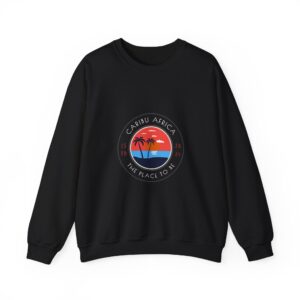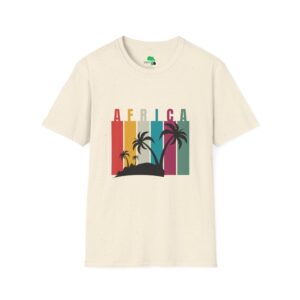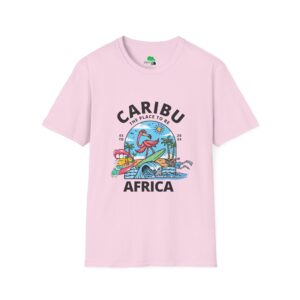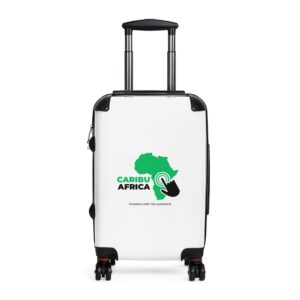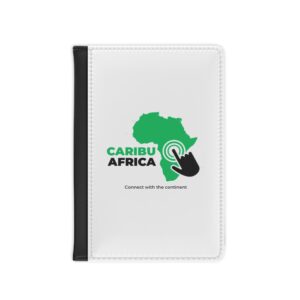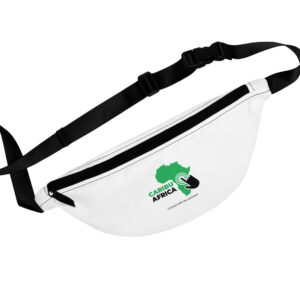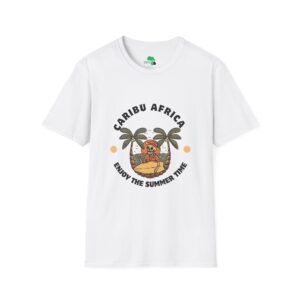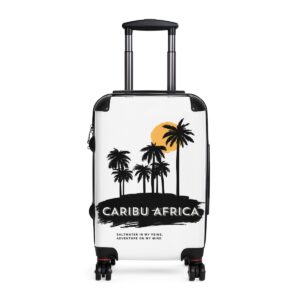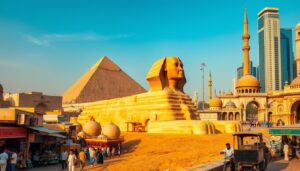February is a special time in Tanzania, with about 500,000 wildebeest calves born. So, when is the best time to visit? It really depends on what you want to do. Tanzania welcomes visitors all year, but the best time varies by preference.
The dry season, from July to October, is perfect for safaris and seeing the Great Migration. This is a key part of the tanzania travel season.
In the dry season, spotting wildlife is easier because the grass is shorter. If you’re planning a trip, the long dry season is the best time. It’s the peak tanzania travel season, but places like the Serengeti and Ngorongoro Crater can be busy.
Key Takeaways
- Tanzania is a year-round destination, but the best time to visit depends on your preferences.
- The dry season, from July to October, is ideal for safari adventures and witnessing the Great Migration.
- The dry season is the peak tanzania travel season, and popular destinations can get crowded.
- When is the best time to travel to Tanzania depends on the activities you want to do.
- The long dry season is the best time to travel to tanzania for safari adventures.
- The tanzania travel season offers a unique experience, with approximately 500,000 wildebeest calves born in February.
Understanding Tanzania's Climate and Seasons
Tanzania’s climate stays the same all year, with altitude being the main factor in temperature. The country has two main seasons: dry and wet. For tanzania weather for tourists, knowing these seasons is key to planning a trip. The dry season, from June to October, has little to no rain. The wet season, from November to May, sees a lot of rain.
The climate in tanzania for travelers is unique, with temperatures changing with altitude. The highlands are cooler, and the lowlands are warmer. Daytime temperatures range from 70°F to 90°F, and nighttime temperatures from 50°F to 60°F. Knowing these temperatures helps travelers pack right and enjoy their trip.
Overview of Tanzania's Climate Zones
Tanzania’s climate zones vary from tropical to temperate. The country’s altitude ranges from 3,000 to 7,000 feet, leading to different climates. The heaviest rains fall from mid-March to May, with a shorter rain period from November to mid-January.
How Seasons Affect Travel
The seasons in Tanzania greatly impact travel plans. The dry season, from June to October, is ideal for visiting, with cooler temperatures and less rain. The wet season, from November to May, can be tough, with lots of rain and humidity. Yet, it’s the best time to see the great wildebeest migration in the Serengeti.
| Season | Months | Temperature | Rainfall |
|---|---|---|---|
| Dry Season | June to October | 70°F to 90°F | Little to no rainfall |
| Wet Season | November to May | 50°F to 90°F | Frequent rainfall |
By understanding Tanzania’s climate and seasons, travelers can plan their trip well and enjoy their time in the country.
Best Time for Safari Adventures
Planning a safari in Tanzania? Knowing the tanzania safari timing is key. The dry season, from June to October, is the best time. This is because the grass is shorter and animals gather near water, making them easier to see.
The ideal months to visit tanzania for a safari are June to August. This is the peak season with cooler weather and more wildlife. You’ll also see the Mara River crossing in June-July, offering great views.
Here are some key points to consider when planning your safari adventure:
- June to September: Best time for safaris in Tanzania due to the dry season
- July and August: Best months to witness the Great Migration, particularly the herds crossing the Mara River
- January and February: Offer greener landscapes and a calving season in full swing, making it a low season and less crowded for tourists
| Month | Temperature (°C) | Precipitation (mm) |
|---|---|---|
| July | 14-26 | 13 |
| August | 15-27 | 28 |
| April | 18-28 | 156 |
By considering the tanzania safari timing and the ideal months to visit tanzania, you can plan an unforgettable safari adventure in this incredible country.
Exploring Tanzania's Coastline
Tanzania’s coastline is a mix of relaxation and adventure, perfect for a vacation. The dry season, from June to October, is best for beach activities. Warm weather and calm seas are great for swimming, snorkeling, and diving.
The coastal region is ideal for a Tanzania vacation. June to September is the best time, with cooler and dry weather. April is also good, with beautiful sunsets and fewer crowds.
When planning a trip to Tanzania’s coastline, consider the seasons. The rainy season, from November to May, is good for seeing marine life. But the dry season is better for visiting the north, except for wildlife migrations.
Top activities on the coastline include:
- Snorkeling and diving in the clear waters
- Relaxing on the beautiful beaches
- Spotting marine life, including dolphins and whales
Enjoying Mount Kilimanjaro Treks
Climbing Mount Kilimanjaro is an exciting adventure. It offers stunning views and a unique experience. When planning your climb, consider the climate in Tanzania for travelers. The weather can greatly affect your journey.
The ideal months to visit Tanzania for climbing Mount Kilimanjaro are June to October. This is the dry season.
The best time to climb is during the warmest and driest periods. This is from December to mid-March and mid-June to October. January and February are the warmest months. They have sunny mornings and evenings, but afternoons may see rain.
Best Months for Hiking
Here are the recommended months for climbing Mount Kilimanjaro:
- June: cold weather, medium cloudiness, and medium crowds
- July and August: cold weather, low cloudiness, and high crowds
- September and October: moderate weather, low cloudiness, and high crowds
- December: moderate weather, medium cloudiness, and medium crowds
Weather Conditions on the Mountain
The weather on Mount Kilimanjaro changes with the month and climate zone. Here’s a summary of the weather, cloudiness, crowd level, and recommendations for each month:
| Month | Weather | Cloudiness | Crowd Level | Recommendation |
|---|---|---|---|---|
| January | Warm | Low | High | Recommended |
| February | Warm | Low | High | Recommended |
| March | Moderate | High | Low | Not Recommended |
| April | Moderate | High | Low | Not Recommended |
| May | Moderate | High | Low | Not Recommended |
| June | Cold | Medium | Medium | Recommended |
| July | Cold | Low | High | Recommended |
| August | Cold | Low | High | Recommended |
| September | Moderate | Low | High | Recommended |
| October | Moderate | Low | High | Recommended |
| November | Moderate | Medium | Low | Not Recommended |
| December | Moderate | Medium | Medium | Recommended |
Experiencing Cultural Festivals
Tanzania’s cultural festivals are a big part of its identity. Attending them can make your trip even better. The timing of your safari is key, especially to see the Great Migration from July to October.
Don’t miss the Zanzibar International Film Festival, the Bagamoyo Festival, and the Mwaka Kogwa Festival. They show off Tanzania’s lively culture and traditions. These festivals happen from June to October, perfect for safaris and cultural adventures.
- Zanzibar International Film Festival (ZIFF) – held annually in July in Zanzibar’s Stone Town
- Sauti za Busara – a festival celebrating African music, takes place in February in Zanzibar’s Stone Town
- Ngorongoro Traditional Cultural Festival – celebrating Maasai traditions, happens in August near the Ngorongoro Crater
These festivals are a fantastic way to dive into local culture and meet the people. By planning your safari around these events, you’ll have an unforgettable trip.
| Festival | Month | Location |
|---|---|---|
| ZIFF | July | Zanzibar’s Stone Town |
| Sauti za Busara | February | Zanzibar’s Stone Town |
| Ngorongoro Traditional Cultural Festival | August | Ngorongoro Crater |
Wildlife Migration: Timing Your Visit
Planning a trip to Tanzania? Knowing when the wildlife migrates is key. The Great Migration, a world-famous event, happens from July to October. Millions of wildebeest, zebras, and gazelles move in search of food.
For the best time to visit, look at the tanzania travel season. The dry season, from June to October, is perfect for seeing the Great Migration. Temperatures are pleasant, with highs around 25°C / 77°F and lows around 14°C / 57°F. This is the best time to see the iconic river crossings.
Best Months to Witness the Migration
The best months to see the Great Migration are July to October. During this time, animals move from the Serengeti to the Maasai Mara in Kenya. For a quieter experience, visit in mid-March to mid-May or early November to mid-December.

- June to October: Dry season, ideal for witnessing the Great Migration
- July to October: Best months to see the iconic river crossings
- Mid-March to mid-May: Low season, fewer tourists, and lower rates
By knowing when animals migrate and the tanzania travel season, you can plan your trip well. This way, you’ll make the most of your visit.
Optimal Months for Bird Watching
Tanzania is a haven for birdwatchers, with over 1,100 bird species. The tanzania weather for tourists and climate in tanzania for travelers greatly affect the best bird watching times. The wet season, from November to May, is ideal. This is because the rains bring nutrient-rich waters that draw in many bird species.
The dry season, from June to October, is also good for bird watching. During this time, the grasses are shorter, and birds gather around waterholes and rivers. The climate in tanzania for travelers is warm all year, making it perfect for birdwatching.
Bird Species to Look Out For
- Resident birds, such as the lilac-breasted roller and the African fish eagle
- Migratory birds, such as the European roller and the Amur falcon
- Endemic species, such as the Usambara weaver and the Tanzanian red-billed hornbill
Migratory Patterns and Timing
The migratory patterns of birds in Tanzania are shaped by the tanzania weather for tourists and food availability. The short rainy season, from November to March, draws in birds from Europe and Asia. The long rainy season, from April to May, sees birds engaging in courtship and nesting.
Timing for Zanzibar’s Beach Vibe
Zanzibar is a tropical island with a mix of relaxation and adventure. It’s perfect for a beach vacation. The prime time to go to tanzania is from June to October. This is when the weather is warm and the seas are calm, ideal for swimming, snorkeling, and diving.
When planning a trip to Zanzibar, think about the top times for tanzania vacation. June, July, and August are the best months. They offer great conditions for water activities and exploring the island’s beautiful beaches.
Some of the top activities to enjoy in Zanzibar include:
- Snorkeling and diving in the crystal-clear waters
- Relaxing on the stunning beaches, such as Matemwe and Nungwi
- Exploring the historic Stone Town, a UNESCO World Heritage Site
April is also a great time to visit Zanzibar. The sunsets are stunning, and the beaches are less crowded. With its unique blend of relaxation and adventure, Zanzibar is an ideal destination for a prime time to go to tanzania and experience the top times for tanzania vacation.
| Month | Weather | Activities |
|---|---|---|
| June | Dry and warm | Snorkeling, diving, and beach relaxation |
| July | Dry and warm | Exploring Stone Town, water sports, and island tours |
| August | Dry and warm | Beach activities, water sports, and cultural events |
Cost Considerations Throughout the Year
Planning a trip to Tanzania means looking at the tanzania travel season costs. The high season, from July to October, is pricier. Prices for safaris and places to stay are at their highest. But, the low season, from November to May, can save you a lot, with some tours cutting prices by up to 40%.
The tanzania safari timing affects costs too. In peak season, budget-friendly places cost $400 to $565 per night for each person. Mid-range spots are $620 to $850 per night. Luxury options can be $1000 to $1500 per night.
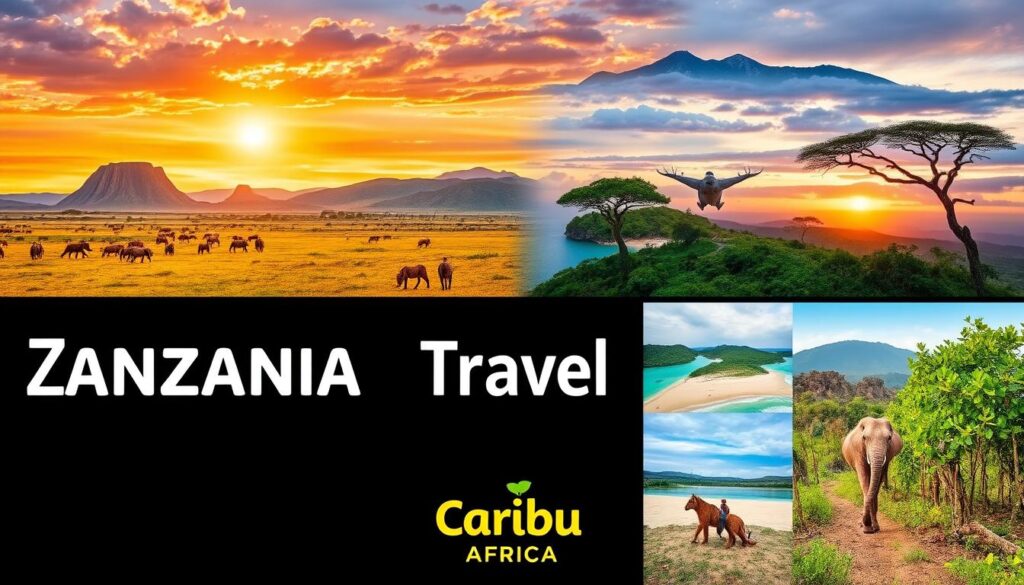
Traveling in the shoulder season, like February, June, or January, can save up to 20% on safaris. Also, picking basic places and traveling in groups can cut costs. Here are some tips to save money:
- Opt for a shared (group) safari package, which can cost from $250 per person per day
- Choose a budget-friendly accommodation, with prices starting from $400 per person per night
- Travel during the low season, when prices are significantly lower
By thinking about these costs and planning well, you can have a great and affordable tanzania travel season trip.
Family Travel: Finding the Right Time
Planning a family trip to Tanzania? Think about the best time to go. The dry season, from June to October, is great for family travel. The weather is dry, and the roads are safer.
This time is perfect for wildlife viewing and outdoor fun. Families can explore Tanzania’s national parks and game reserves.
During the dry season, families can enjoy many activities. Safari adventures, beach holidays, and cultural festivals are all options. The tanzania travel season offers a special experience for families. Many tour operators have guided tours and activities for families.
To have the best trip, visit during the dry season. The weather is nice, and there’s plenty of wildlife to see.
The best time for families to visit Tanzania is from June to October. This period has minimal rainfall and comfortable temperatures. Some fun activities for families include:
- Safari adventures in the Serengeti and other national parks
- Beach holidays in Zanzibar and other coastal towns
- Cultural festivals and events, such as the Zanzibar International Film Festival
The dry season is the best time for family travel to Tanzania. It offers a unique and unforgettable experience for all ages. Tanzania is perfect for families looking for an exciting and educational adventure.
| Month | Activity | Location |
|---|---|---|
| June | Safari adventure | Serengeti National Park |
| July | Beach holiday | Zanzibar |
| August | Cultural festival | Stone Town |
Preparing for Rainy Seasons
Traveling to Tanzania means you should know about the weather, especially during rainy seasons. The climate can be tough, but with the right prep, you can have fun. The rainy season is from November to May, so plan your trip wisely.
The highlands are cooler and wetter, while the lowlands are warmer and drier. To get ready for rain, pack a rain jacket and sturdy shoes. Also, keep these tips in mind:
- Use a 4×4 vehicle to navigate through rough terrain
- Avoid traveling during heavy rainfall
- Stay informed about weather conditions and plan your itinerary accordingly
Knowing the weather and climate is key to a great trip. Being prepared and flexible lets you enjoy Tanzania’s beauty, even in the rain.
| Month | Weather Conditions |
|---|---|
| November to May | Wet season, with heavy rainfall and high humidity |
| June to October | Dry season, with minimal rainfall and low humidity |
Conclusion: Planning Your Perfect Trip
When planning your trip to Tanzania, think about the best time for you. The dry season, from June to October, is great for safaris and beach fun. But, the wet season, from November to May, has its own charm. You can see the Great Wildebeest Migration and enjoy cultural festivals.
Being flexible with your plans is smart. This way, you can adjust your trip to fit the weather and your interests. Tanzania offers amazing adventures all year round. Whether you’re into safaris or exploring green landscapes, you’re in for a treat.
FAQ
When is the best time to travel to Tanzania?
Tanzania welcomes visitors all year round. The best time to visit depends on what you want to do. The dry season, from July to October, is perfect for safaris and seeing the Great Migration. This time, the grass is short, making wildlife easier to spot.
What are the main seasons in Tanzania and how do they affect travel?
Tanzania has a tropical climate with two main seasons. The dry season runs from June to October, and the wet season from November to May. Knowing these seasons helps plan your trip and enjoy your time in Tanzania.
What is the best time for safari adventures in Tanzania?
The dry season, from June to October, is the best for safaris. The grass is short, and animals gather around water, making them easier to see. It’s also the best time to see the Great Migration.
When is the best time to visit Tanzania’s coastline?
June to October is the best for beach holidays. The weather is warm, and the seas are calm. The wet season is good for spotting marine life, as the rains bring nutrient-rich waters.
What is the best time to climb Mount Kilimanjaro?
Climbing Mount Kilimanjaro is best in the dry season, from June to October. The weather is dry, and the trails are less slippery. However, the wet season is less crowded and offers lush scenery.
When are the best cultural festivals and events in Tanzania?
Tanzania hosts many festivals and events throughout the year. These include the Great Migration, the Zanzibar International Film Festival, and the Mwaka Kogwa Festival. These events showcase Tanzania’s vibrant culture and traditions.
When is the best time to witness the Great Migration in Tanzania?
The best time to see the Great Migration is from July to October. However, the migration happens all year, and the best time varies by location.
What is the best time for bird watching in Tanzania?
The wet season, from November to May, is best for bird watching. The rains attract many bird species. The dry season is also good, as birds gather around waterholes.
When is the best time to visit Zanzibar?
June to October is ideal for Zanzibar beach holidays. The weather is warm, and the seas are calm. The wet season is good for spotting marine life.
How does the cost of traveling to Tanzania vary throughout the year?
Travel costs in Tanzania vary by season. The high season, from July to October, is more expensive. The low season, from November to May, is cheaper and less crowded. Budget-friendly tips include visiting during the low season and using public transport.
What is the best time for families to visit Tanzania?
June to October is good for family travel, with dry weather and less slippery roads. The wet season offers lush scenery and lower prices. Activities include safaris, beach holidays, and cultural festivals.
How can travelers prepare for the rainy season in Tanzania?
The wet season can be challenging, but with preparation, you can still have a great trip. The highlands are cooler and wetter, while the lowlands are warmer and drier. Safety tips include using a 4×4 vehicle and carrying a rain jacket.

